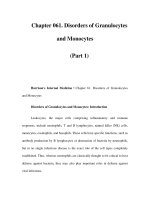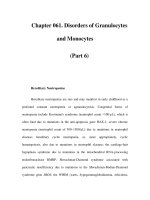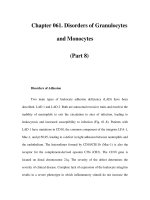Lecture E-Commerce - Chapter 11: E-commerce business model and concepts (part I)
Bạn đang xem bản rút gọn của tài liệu. Xem và tải ngay bản đầy đủ của tài liệu tại đây (352.97 KB, 28 trang )
CSC 330 E-Commerce
Teacher
Ahmed Mumtaz Mustehsan
GM-IT CIIT Islamabad
Virtual Campus, CIIT
COMSATS Institute of Information Technology
T1-Lecture-11
T1-Lecture-11
Ahmed Mumtaz Mustehsan
Copyright © 2010 Pearson Education, Inc
1-1
T1-Lecture-11
E Commerce Business Model and
Concepts
Chapter-05
Part -I
For Lecture Material/Slides Thanks to: Copyright © 2010 Pearson Education, Inc
T1-Lecture-11
Ahmed Mumtaz Mustehsan
Copyright © 2010 Pearson Education, Inc
1-2
Objectives
Identify
the key components of e-commerce business
models.
1. Value proposition
2. Revenue model
3. Market opportunity
4. Competitive environment
5. Competitive advantage
6. Market strategy
7. Organizational development
8. Management team
Describe the major B2C business models.
T1-Lecture-11
Ahmed Mumtaz Mustehsan
Copyright © 2010 Pearson Education, Inc
1-3
E-commerce Business Models
Business model
A business model is a set of planned activities ( also
called business processes) designed to result in a profit
in a marketplace.
The business model is at the center of the business
plan.
Business plan : Describes a firm’s business model
E-commerce business model
◦A business model that aim to Use and leverages
the unique qualities of Internet and World Wide
Web.
◦Eight key ingredients of Business Model
T1-Lecture-11
Ahmed Mumtaz Mustehsan
Copyright © 2010 Pearson Education, Inc
1-4
Key Ingredients of a Business Models
T1-Lecture-11
Ahmed Mumtaz Mustehsan
Copyright © 2010 Pearson Education, Inc
1-5
8 Key Elements of a Business Model
1.
2.
3.
4.
5.
6.
7.
8.
T1-Lecture-11
Value proposition
Revenue model
Market opportunity
Competitive environment
Competitive advantage
Market strategy
Organizational development
Management team
Ahmed Mumtaz Mustehsan
Copyright © 2010 Pearson Education, Inc
1-6
1. Value Proposition
1.
2.
Why should the customer buy from you?
What will your firm provide that other firms do not and
cannot?
A value proposition defines how a company’s product
or service fulfills the needs of customers.
Successful e-commerce value propositions:
◦Personalization/customization
◦Reduction of product search, price discovery costs
◦Facilitation of transactions by managing product
delivery
Example: Before Amezone.com ? The customers used to
visit supermarket; Book shops, keep waiting for the
availability of the book; keep coming back!!!
T1-Lecture-11
Ahmed Mumtaz Mustehsan
Copyright © 2010 Pearson Education, Inc
1-7
2. Revenue Model
How will the firm earn revenue, generate profits, and
produce a superior return on invested capital?
Advertising revenue model
A company provides a forum for advertisements and
receives fees from advertisers.
Yahoo.com, for instance, derives a significant amount
of its revenue from selling advertising such as banner
ads.
Subscription revenue model
A company offers its users content or services charges
a subscription fee for access to some or all of its
offerings.
Yahoo, has broadened its business model to include a
monthly subscription to Yahoo Platinum, which gives
viewers access to CNN, NASCAR racing, ABC News,
and other video feeds.
T1-Lecture-11
Ahmed Mumtaz Mustehsan
Copyright © 2010 Pearson Education, Inc
1-8
2. Revenue Model contd…..
Transaction fee revenue model
a company receives a fee for enabling or executing a
transaction.
For example, eBay.com an online auction marketplace
receives a small transaction fee from a seller if the
seller is successful in selling the item.
E-Trade.com, an online stockbroker, receives
transaction fees each time it executes a stock
transaction on behalf of a customer
Sales revenue model
companies derive revenue by selling goods,
information, or services to customers.
Companies such as Amazon.com (which sells books,
music, and other products), LLBean.com, and
Gap.com, all have sales revenue models.
T1-Lecture-11
Ahmed Mumtaz Mustehsan
Copyright © 2010 Pearson Education, Inc
1-9
2. Revenue Model contd…..
Affiliate revenue model
sites that steer business to an “affiliate” receive a
referral fee or percentage of the revenue from any
resulting sales.
For example, MyPoints.com makes money by
connecting companies with potential customers by
offering special deals to its members. When they
make a purchase, members earn “points” they can
redeem for freebies, and MyPoints.com receives a
fee.
Community feedback sites such as Epinions.com
receive much of their revenue from steering potential
customers to Web sites where they make a purchase
T1-Lecture-11
Ahmed Mumtaz Mustehsan
Copyright © 2010 Pearson Education, Inc
110
2. Five Primary Revenue Model
T1-Lecture-11
Ahmed Mumtaz Mustehsan
Copyright © 2010 Pearson Education, Inc
111
3. Market Opportunity
What
marketspace do you intend to serve and what is
its size?
◦Marketspace: Area of actual or potential commercial
value in which company intends to operate
◦Realistic market opportunity: Defined by revenue
potential in each of market niches in which company
hopes to compete
Market
opportunity typically divided into smaller niches
T1-Lecture-11
Ahmed Mumtaz Mustehsan
Copyright © 2010 Pearson Education, Inc
112
4. Competitive Environment
Who else occupies your intended marketspace?
Other companies selling similar products in the same
marketspace
Includes both direct and indirect competitors
Example: automobile manufacturers and airline
companies operate in different industries, but compete
indirectly because they offer alternative means of
transportation.
CNN.com and ESPN.com compete for airtime
consumed by the clients.
Competitive environment Influenced by:
Number and size of active competitors
Each competitor’s market share
Competitors’ profitability
Competitors’ pricing
Customer buying power.
T1-Lecture-11
Ahmed Mumtaz Mustehsan
Copyright © 2010 Pearson Education, Inc
113
5. Competitive Advantage
What special advantages does your firm bring to the
marketspace?
Achieved when firm produces superior product or can
bring product to market at lower price than competitors
Important concepts:
Asymmetries : exists whenever one participant in a
market has an edge than others due to more resources
such as financial backing, knowledge, information, and/or
power.
Example: AOL.com offered music subscription of their
250,000 songs catalog through MusicNet
First-mover advantage: is a competitive market
advantage for a firm that results from being the first into a
marketplace with a serviceable product or service. For
example Amazon.com
T1-Lecture-11
Ahmed Mumtaz Mustehsan
Copyright © 2010 Pearson Education, Inc
114
5. Competitive Advantage
Unfair
competitive advantage: occurs when one firm
develops an advantage based on a factor that other
firms cannot purchase. For example, a brand name
cannot be purchased and is in that sense an “unfair”
advantage. brands are built upon loyalty, trust, reliability,
and quality.
Leverage: when a company use its competitive
advantages to achieve more advantage in surrounding
markets. For example Amazon.com move into the
online auction arena leveraged the company’s customer
database, offering one more way to buy from Amazon
A perfect markets, in which there are no competitive
advantages or asymmetries because all firms have
access to all the factors of production
T1-Lecture-11
Ahmed Mumtaz Mustehsan
Copyright © 2010 Pearson Education, Inc
115
6. Market Strategy
How do you plan to promote your products or services to
attract your target audience?
Details how a company intends to enter market and
attract customers
Best business concepts will fail if not properly marketed
to potential customers
Example:
AOL, uses sampling of millions of free CD ROMs to attract
new users. AOL encloses CDs with free trial offer
in magazines and newspapers across the country. This
strategy has proven to be very successful for AOLs
T1-Lecture-11
Ahmed Mumtaz Mustehsan
Copyright © 2010 Pearson Education, Inc
116
7. Organizational Development
What
types of organizational structures within the firm
are necessary to carry out the business plan?
Organizational
development Plan that describes how
the company will organize the work that needs to be
accomplished.
◦Typically divided into functional departments
◦Hiring moves from generalists to specialists as
company grows
T1-Lecture-11
Ahmed Mumtaz Mustehsan
Copyright © 2010 Pearson Education, Inc
117
8. Management Team
What kinds of experiences and background are
important for the company’s leaders to have?
Employees are responsible for making the business
model work
Strong management team gives instant credibility to
outside investors
Strong management team may not be able to salvage
a weak business model, but should be able to change
the model and redefine the business as it becomes
necessary
Important Questions to be answered:
answered What kind of technical
background is desirable? What kind of supervisory experience is
necessary? How many years in a particular function should be
required? What job functions should be fulfilled first: marketing,
production, finance, or operations?
T1-Lecture-11
Ahmed Mumtaz Mustehsan
Copyright © 2010 Pearson Education, Inc
118
Categorizing E-commerce Business Models
No
one correct way
We categorize business models according to:
◦E-commerce sector (B2C, B2B, C2C)
◦Type of e-commerce technology; i.e., m-commerce
Similar business models appear in more than one
sector
Some companies use multiple business models; e.g.,
eBay
T1-Lecture-11
Ahmed Mumtaz Mustehsan
Copyright © 2010 Pearson Education, Inc
119
B2C Business Models: Portal
Offers
users powerful Web search tools as well as an
integrated package of content and services all in one
place.
Revenue models:
◦Advertising, subscription fees, transaction fees
Variations:
Horizontal/General : they define their marketspace to
include all users of the Internet. Examples are Yahoo,
AOL, MSN, and others like them
Vertical/Specialized
(Vortal): attempt to provide similar
services as horizontal portals, but are focused around
a particular subject matter or market segment.
Example sailnet.com
T1-Lecture-11
Ahmed Mumtaz Mustehsan
Copyright © 2010 Pearson Education, Inc
120
B2C Models: E-tailer
e-tailers, come in all sizes and shapes, from giant
Amazon.com to tiny local stores that have Web sites.
E-tailers Online version of traditional retailer
Revenue model: Sales of products and services
Variations:
Virtual merchant: are subsidiaries of existing physical
stores and carry the same products.
Bricks-and-Mortars / Bricks-and-clicks: companies with
complementary online stores.
T1-Lecture-11
Ahmed Mumtaz Mustehsan
Copyright © 2010 Pearson Education, Inc
121
B2C Models: E-tailer
Variations: (Continued).
Catalog merchant: such as online versions of direct mail
catalogs, online malls.
Manufacturer-direct: Offering their products directly to
consumers.
Low barriers to entry: tens of thousands of small e-tail shops
have sprung up on the Web as the total cost of entering (a
new marketplace) into the Web e-tail market are low.
T1-Lecture-11
Ahmed Mumtaz Mustehsan
Copyright © 2010 Pearson Education, Inc
122
B2C Models: Content Provider
Content providers distribute information/ digital contents
over the Web such as:
digital news, music, photos, videos, and artwork.
Retrieving and paying for content is the second largest
revenue source for B2C e-commerce
Revenue models:
Subscription; pay per download (micropayment);
advertising;
affiliate referral fees
Variations:
Content owners: owners of copyrighted content such
as publishers of books and newspapers, broadcasters
of radio and television content, music publishers, and
movie studios
T1-Lecture-11
Ahmed Mumtaz Mustehsan
Copyright © 2010 Pearson Education, Inc
123
B2C Models: Content Provider
Variations: (continued)
Syndication: Some content providers, however, do not
own content, but syndicate (aggregate) and then
distribute content produced by others.
Syndication
(Web aggregators) is a major variation of
the standard content provider model.
T1-Lecture-11
Ahmed Mumtaz Mustehsan
Copyright © 2010 Pearson Education, Inc
124
B2C Models: Transaction Broker
T1-Lecture-11
Ahmed Mumtaz Mustehsan
Copyright © 2010 Pearson Education, Inc
125









